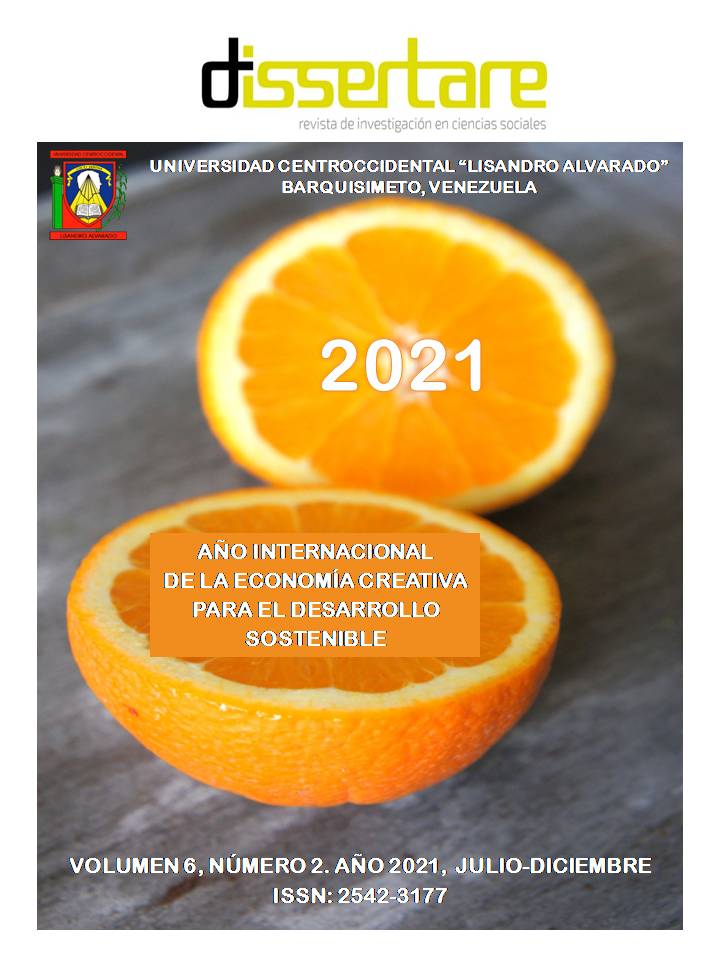Minimal phrases system for translating English to Spanish
Keywords:
translation, noun phrase, minimal phrases, parts of speechAbstract
This article is the advance of a broader investigation, so its purpose is framed in presenting the progress of a translation system proposed to translate from English to Spanish applying minimal phrases. The research from which this work originates is of a qualitative type with emergent design and hermeneutical phenomenological method. The scope of study was the Dean of Sciences and Technology of the Universidad Centroccidental "Lisandro Alvarado" (UCLA, Venezuela). Observation and the self-administered survey were applied as information gathering techniques. In this sense, two English classes were observed on the content of the noun phrase, taught by different teachers. The survey was applied to 5 sections of students from the careers Computer Engineering, Systems Analysis, Production Engineering, Bachelor of Mathematics and Degree in Physics; from there, 5 questionnaires were selected. Triangulation was applied from the collected information contrasted with the theoretical references. So far, the analyzes have allowed the following interpretations to be made: a) teachers use the content of the noun phrase as the main element for teaching translation from English to Spanish; b) Students can recognize the nucleus in short noun phrases, however, when the phrase is accompanied by premodifiers and postmodifiers, it becomes confusing for the student.
Downloads
References
Alecoy, T. J. (2015). English from the base for all spanish speakers. Ingles para hispanohablantes. https://books.google.co.ve/books?id=Gli4CgAAQBAJ&printsec=frontcover&hl=es#v=onepage&q&f=false
Alvira, F. (2011). La encuesta: una perspectiva general metodológica. Cuadernos metodológicos.
Arroyave Tobón, A. y Quiroz Herrera, G. (2012). Consideraciones didácticas para la enseñanza de sintagmas nominales con premodificación compleja del inglés al español. Núcleo, (29), 179 – 215. http://ve.scielo.org/pdf/nu/v24n29/art08.pdf
Batista, J. (2009). La traducción en la enseñanza del inglés científico-técnico. Un análisis retrospectivo y prospectivo. Impacto Científico, 1(1), 1-20. https://produccioncientificaluz.org/index.php/impacto/article/view/366/365
Bunge, M. (2008). Filosofía y sociedad. Siglo XXI. https://books.google.co.ve/books?id=ftUz1u_deh8C&printsec=frontcover&hl=es&source=gbs_ge_summary_r&cad=0#v=onepage&q&f=false
Hamilton-Toovey, S. y Mateluna, M. (2001). La traducción al español de los nominales complejos del inglés. BFUCh, (XXXVIII), 127-166. https://boletinfilologia.uchile.cl/index.php/BDF/article/view/19484/20644
Martínez, M. (2006). La investigación cualitativa (síntesis conceptual). Revista de Investigación en Psicología, 9(1),135-141. https://sisbib.unmsm.edu.pe/bvrevistas/investigacion_psicologia/v09_n1/pdf/a09v9n1.pdf.
Martínez, M. (2009). Evaluación cualitativa de programas. Editorial Trillas.
Murillo, O. (2006). Lectura en inglés. Curso básico. EUNED. https://books.google.co.ve/books?id=HcXRAR1ui6YC&printsec=frontcover&hl=es#v=onepage&q&f=false
Oliver, A. (2014). Traducción y tecnologías, procesos, herramientas y recursos. Universitat Oberta de Cataluña. http://openaccess.uoc.edu/webapps/o2/bitstream/10609/79008/9/Traducci%C3%B3n%20y%20tecnolog%C3%ADas%2C%20herramientas%2C%20procesos%20y%20recursos_M%C3%B3dulo%204_La%20traducci%C3%B3n%20autom%C3%A1tica.pdf
Ortega, V. (2012). El inglés de la tecnología y la ciencia. Teoría y práctica de la comprensión del inglés escrito. Editorial Horizonte C.A.
Real Academia Española (2021). Diccionario de la lengua española. https://dle.rae.es/?formList=form&w=traducir#
Rivero de Magnago, M., Loyo, A. C., Blasón, M. V. y González, M. L. (2004) Inglés. Elementos de gramática. Universidad Nacional de Río. https://books.google.co.ve/books?id=UTdBw3dD8P8C&printsec=frontcover&hl=es#v=onepage&q&f=false
Ruiz Costa-jussá, M. y Fonollosa, J. (2005). Técnicas mejoradas para la traducción basada en frases. Procesamiento del Lenguaje Natural, (35), 351-356. https://www.redalyc.org/articulo.oa?id=515751735043
Vez, J. M. y Valcarcel, M. (1989). La formación de profesores en didáctica del inglés. Orientaciones para la enseñanza básica obligatoria. https://books.google.co.ve/books?id=FbPYEAXaBZIC&printsec=frontcover&hl=es#v=onepage&q&f=true
Weffer Martínez, E. M. (2012). Estrategias de traducción para formular equivalencias inglés-español del sintagma nominal extenso especializado “deepsalinewater-saturatedreservoirrocks”, en un corpus de cambio climático (Tesis de Maestría). Universidad Autónoma de Manizales.
Published
How to Cite
Issue
Section
Copyright (c) 2021 Dra. Beatriz Terán

This work is licensed under a Creative Commons Attribution-NonCommercial-ShareAlike 4.0 International License.
Derechos del/de autor/es a partir del año de publicación
Esta obra está bajo la licencia:
Creative Commons Reconocimiento-NoComercial-CompartirIgual 4.0 Internacional (CC BY-NC-SA 4.0)
Las opiniones expresadas por los autores no necesariamente reflejan la postura del editor de la publicación ni de la UCLA. Se autoriza la reproducción total o parcial de los textos aquí publicados, siempre y cuando se cite la fuente completa y la dirección electrónica de esta revista. Los autores(as) tienen el derecho de utilizar sus artículos para cualquier propósito siempre y cuando se realice sin fines de lucro. Los autores(as) pueden publicar en internet o cualquier otro medio la versión final aprobada de su trabajo, luego que esta ha sido publicada en esta revista.





